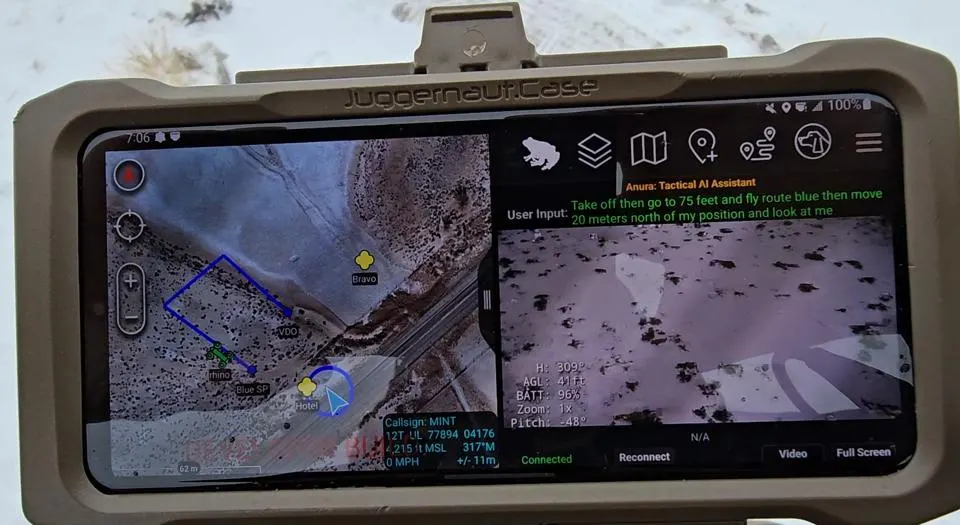Teal Drones Is Making It Possible to Fly Drones with Voice Commands
BY Zacc Dukowitz
12 March 2024In the movie Blade Runner 2049 the lead character, played by Ryan Gosling, has a drone he can fly by talking to it.
He arrives at a location, puts the drone in the air, and tells it what to do—that simple.
Well, it’s only 2024 but Teal Drones has actually made a drone you can fly using voice control.
Adding voice control into our products is another step toward our goal of building the best-in-class rucksack portable drone. The flexibility provided by voice control, combined with the existing features in our offering, will continue to push Teal’s drones into a leadership position.
– George Matus, CTO at Teal Drones
The first drone Teal is adding the voice command capability to is the Teal 2, its flagship drone for ISR (Intelligence, Surveillance and Reconnaissance). Teal also makes drone swarm technology, and eventually voice commands will be rolled out for flying swarms as well.
Teal Drones’ UAVs are now made primarily for defense and security applications, so the idea is that a soldier will be able to speak into the radio, telling the drone what to do while keeping their hands free.
How Does It Work?
To make voice control possible, Teal teamed up with Primordial Labs, a Connecticut-based company that’s developed a voice-based software called Anura.
Anura is powered by AI and acts as an interface between hardware and speech, interpreting what people say and turning it into specific flight commands. It’s made to run alongside command and control software on several types of devices, including drones.
The idea is to make collaborating with robots more natural for humans. It’s not necessarily making the robot more human, which I think is the traditional [view]. Rather, it’s to make the mechanism of communication more human.
– Lee Ritholtz, CEO and Cofounder of Primordial Labs
One key difference between Ryan Gosling’s voice-controlled drone in Blade Runner and the technology Teal Drones is working on is that, in the real-life version, you can’t just talk and have the drone react.
And that’s because, as you might imagine, the drone won’t be able to hear you. Instead, soldiers in the field will wear a headset and use special devices to relay the sound of their voice to the drone.
One device that can relay the sound of an operator’s voice to the drone is called an ATAK (Android Tactical Assault Kit)—essentially a Samsung phone that’s mounted on your chest. Another is a body-worn controller, such as a Tomahawk Robotics KxM.


Anura running on a Samsung phone | Credit: Primordial Labs
But whether it’s a phone or a controller, either one can use Anura to relay what the soldier says, turning spoken words into flight commands.
Special Commands vs. Natural Language
You might imagine that pilots will need special training to use voice control, with specific commands needed to get the behavior you want from the drone. And understanding these commands could require special training, so you can learn how to actually get the drone to do what you want.


The Teal 2 | Credit: Teal Drones
But the examples Teal has provided are actually pretty natural, making it sound like anyone can just talk to the drone and get it to fly the way they want.
According to Teal, pilots are “just talking to the drone, giving it . . . mission-type orders.”
Some examples include commands like:
- “Fly route Blue then go to point Echo”
- “Fly 45 degrees for 20 meters, then look at me”
So why would you want to fly a drone with voice commands?
There are several advantages to being able to fly with just your voice. For soldiers, they’ll be able to access aerial intel without having to use their hands, and without having to break visual contact with their drone or surroundings to look at a remote control.
And military operations aren’t the only arena where voice control could be useful. Almost any commercial drone application could benefit from the ability to fly hands-free, allowing the drone to act as a semi-autonomous data collection device.
According to Teal Drones, voice commands are just the beginning of a move toward greater and greater autonomy. As the technology improves, the goal will be to move toward greater predictive action, allowing the drone to move quickly and be symbiotic with the mind of the pilot, anticipating their next request.
In the last year, Teal has been doing an impressive job forming partnerships to boost the performance of its drones.
The new voice command partnership with Primordial Labs is just one more added to a list that’s already long and impressive, and includes Tomahawk Robotics for remote controllers, Doodle Labs for AI-enhanced computer vision, Teledyne FLIR for thermal imaging, and Immervision for night vision, as well as Athena AI and Reveal Technology, not to mention several third-party app capabilities.


